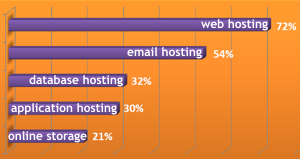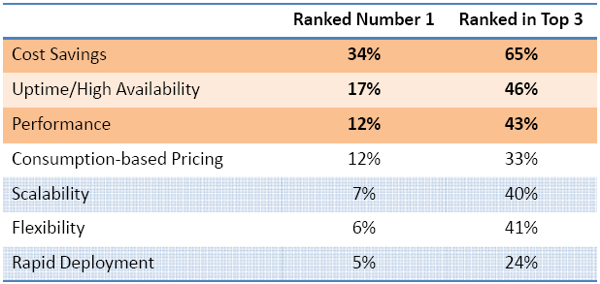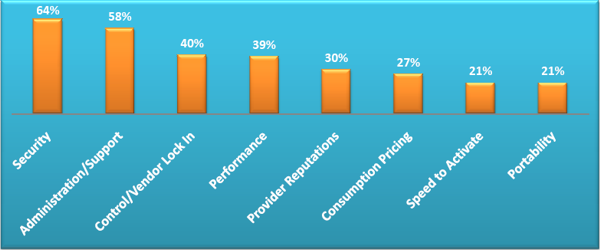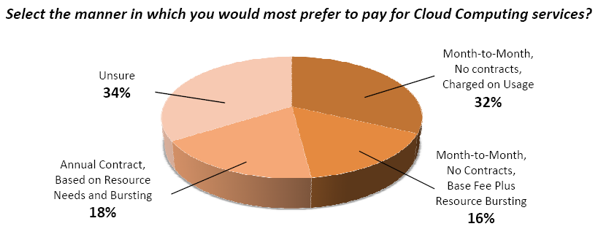The first one to publicly utter the term “Cloud Computing” was Google’s CEO, Eric Schmidt. That was almost three years ago, back in 2006. The first article about “Cloud Computing” in Wikipedia was published on March 3, 2007. Since then, more than 500 versions of the same article have been submitted. A long line of references have also been added to Wikipedia’s “Cloud Computing” page. It took me 216 hours to read them all, and 1 hour to forget almost everything I had read. But let me start by offering two different definitions of “Cloud Computing.”
The good definition – “Cloud Computing is a new, networking model of developing and using computer technologies. It is a paradigm in computer science in which tasks are assigned to a combination of connections, software and services accessed over a network.”
The bad definition – “Google, IBM, Salesforce, Amazon, Microsoft, Yahoo and other corporations found another way to get even richer.” The above mentioned corporations were the first to utilize a major change in computing technologies. They began producing computer systems and platforms that are recognizable by high availability, scalability, load balancing, and the use of a large quantity of computer resources connected through a network.
Why We Need Computer Clouds
I met 24 year old Peter at an IT community event in Bulgaria. He and his partner founded a small dotcom startup company called Clixpy. Clixpy provides a web usability service that tracks everything visitors on any website do such as mouse movements, clicks, scrolling, form inputs and more. We discussed various aspects of online business and when we got to web hosting, I asked him what made him choose his web hosting provider. He said that he chose a specific web hosting provider only because the company offered scalable VPS Hosting and promised him that he can increase the account resources by a single click in his control panel.
When I asked him why he needs a scalable service for a startup project, he answered, “Well, Just imagine that a blog such as TechCrunch, for example, decides to post a review of us. We must be ready to handle the load and ensure that we will be online!” As you may guess, Peter’s company is one of the reputable grid hosting providers. His company doesn’t say it provides Cloud Hosting on its website, but promotes its services and products as “Grid Hosting,” with high availability and scalability among its features.
We obviously need to use more and more computer resources and it is getting harder to put them in a self-contained hardware system. There are several predecessors to the computer Clouds, such as Clusters or Grid systems. All of them represent significant efforts to consolidate hardware and software resources in order to power applications that require tens of thousands, and sometimes even millions of computing processes to be handled within a very short period of time.
Consumers increasingly demand the hosting of large files and web-heavy applications. This forces web hosts and providers of Internet based services to implement significant innovations in the IT infrastructures and the platforms behind them. These innovations may include building more sophisticated networks, setting up new data center architectures based on load-balanced systems, and utilizing various virtualization methods (platform virtualization, resource virtualization, application virtualization, etc.).
Let’s not forget to say a few words about virtualization because Cloud computing is unimaginable without it. For those who are not familiar with the term, “Virtualization” is a technology which refers to abstraction of computer resources. It is a very broad term, but when using it most people refer to “Platform Virtualization” techniques. These techniques include “Full Virtualization” (a complete simulation of the underlying hardware), “Hardware-assisted Virtualization” (simulation of a complete hardware environment using hardware capabilities such as host processors), “Partial Virtualization” (partial simulation of the physical computer), “Paravirtualization” (a software interface to virtual machines, similar to that of the underlying hardware), “OS Virtualization” (method where the kernel of an OS creates multiple isolated instances, instead of just one).
The virtualization technologies mentioned above make possible the transformation of computer clusters, the grid computing infrastructures wе use, into “Computer Clouds.” Some important keywords which are associated with the terms “Cloud” or “Computer Cloud”, include: “efficiency”, “lower costs”, “redundancy”, “modularity”, “low latency”, “Quality of Service (QoS)”, “virtualization”, “Software as a Service (SaaS)”, “Platform as a Service(PaaS)”, and “Infrastructure as a Service (IaaS)”. Any computer platform or service that corresponds with most of above keywords can be defined as a “Cloud” type.
The technologies bridging the gap between computer Clusters we have known for years and new Cloud computing architectures, can be summarized with one phrase, “Platform Virtualization.” It is a technology concept which allows an operating system (OS) to be separated from the underlying platform resources.
The New Rivalry. Who Will Win?
Like any other type of computing, the Cloud concept creates competition of IT services and products in different markets. Those who succeed in producing comprehensive platforms and delivering them as online services (PaaS), will become global IT leaders in the new era of Cloud computing. Google, Amazon, Salesforce, Yahoo and Microsoft are now ahead of others in developing and delivering Cloud computing generation platforms. In the world of computer Clouds these companies, followed by a few other major corporations, are conquering the consumer markets by offering various IT services and products over the Internet. However, they will face tough competition from traditional telecoms, owners of the computer networks, and ISPs. Anyone who wants to provide Cloud computing based IT services must have unlimited access to a very stable, redundant network, which has to be reliable enough so endusers will be able to access remote hardware and software resources. The boom of Cloud based services depends on the development of the IT networks. And their owners will definitely try to grab as big a share of the emerging Cloud market as they can.
Cloud as Infrastructure & as Platform
The first ones to benefit from the above described major transformation in computer technologies are Infrastructure providers. Companies which produce computer infrastructure, computer systems and components, like Intel, AMD, Cisco, IBM, HP, and Apple, might team up with telecoms and networking providers to deliver computer infrastructures as a service (IaaS). To better compete as major Clouds, the above mentioned companies, telecoms and networking providers need to either invest millions in developing their own infrastructures and platforms, or partner with software producers in order to deliver Cloud based services. This is good news for software companies because it creates a huge market for Cloud computing platforms. Teaming up to compete with Google, Microsoft, Yahoo, Amazon and other dot-com giants, competitors will need to adopt different kinds of platform virtualization environments. That’s the reason why many producers of hardware and infrastructure services are now spending a lot in building new generation computer platforms.
Here is the chance for companies that deliver platform virtualization, such as VMware, Oracle, Parallels, and Citrix, to take control of the Clouds. They deliver Cloud computing platforms (PaaS) and software as a service (SaaS) on top of underlying hardware architectures. They are the ones who really make it possible for businesses and end users to move to the Clouds.
I’m not sure how to categorize some of the above major corporations – place them among IaaS producers, to put them under the “SaaS label”, or to classify them as computing platform (PaaS) providers. Companies like IBM, HP, and Apple, for example, will continue to be IT entities that could deliver “everything as a service.”
I’m sure that in real life all the above mentioned IT giants have to partner with other smaller IT companies to survive, especially in times when the world economy is shrinking. I think that the partnership is natural in the Cloud generation of computing. It is a rule, not an exception. The new Cloud partnerships might give birth to new mighty technology brands, or force the closure of companies that have been around for decades.
Cloudware
Today, anyone knows the meaning of “hardware” and “software.” Tomorrow, people will have to make themselves familiar with a new computer term – “Cloudware.” Cloudware refers to computing by building, delivering and using web applications and services through the Internet. A Cloudware provider is anyone who can create and deliver a computer platform as a service (PaaS).
PaaS providers will be the pearls in the Clouds. I predict that Cloudware providers will become the backbones of the technology industry within the next two decades. I have a reason to make this prediction: Cloudware providers will provide all of the facilities required to support the complete cycle of building and delivering web applications and services, entirely available from the Internet, with no software downloads or installation for businesses and end-users.
Cloud Hosting
“Cloud Hosting” can be defined as a web hosting service delivered from a system of servers. The term is not precisely defined, yet. However, it can be very simply explained as a combination of computer clusters and a specific software platform running on top of it. Any hosting service can be considered as Cloud Hosting, when delivered from a fully redundant cluster server system, in which the resources are dynamically scalable and often virtualized. Of course any Cloud Hosting service also has to utilize a computer platform allowing all the services to be delivered and billed on a “pay per use” model.
Linux or Windows Clouds
Without being a software expert, I can see a few companies who are creating standards in Cloud computing. When it comes to Linux based Clouds, the first name that comes to mind is Red Hat. The Amazon web service is built on Red Hat Enterprise Linux (RHEL). Red Hat provides the standards that developers of Linux based Clouds need to build and host applications such as compute capacity, bandwidth, and storage. The Open Source operating system platform – RHEL to be included, of course.
In a white paper titled “Linux: The Operating System of the Cloud”, Amanda McPherson, Vice President of Marketing and Developer Programs Linux Foundation, says: “The dominance of Linux within the current crop of Cloud computing vendors is eye opening. Virtually every Cloud player of any significance features Linux in either primary or supporting capacities, and this adoption is increasing. Google’s recently launched App Engine and Amazon’s competitive EC2 product both leverage the Linux kernel, as do Cloud offerings from vendors such as 10gen, 3Tera, Media Temple, Mosso, and Zimory”.
McPherson’s got a point. The Linux operating system (OS) looks to be winning the “OS war” with Microsoft’s Windows in the Cloud battlefield. At least until Microsoft comes up with a Cloud computing version of its Windows OS. Having a Windows Cloud in its pocket will allow the Silicon Valley company to take its dominance in the software market to the Cloud level. All the same, I cannot give you an answer to one very important question: “Will the Cloud style of computing fit in with Microsoft’s OS, its applications and the company’s strategy in general? In many interviews, I have seen Microsoft’s officials state that they started thinking of how to prepare their company for any kind of Internet based model of computer use in the late 90s. Microsoft has already launched Azure. They are marketing it as an “Operating system for the Cloud”.
Some analysts say that Azure simplifies and automates the Cloud concept that Amazon started. Azure provides a “compute fabric” upon which developers can run their applications based on Microsoft Visual Studio development environment and the Microsoft .NET Framework. The main advantage of the Azure is that it reaches 100% of computer users thanks to Microsoft’s position in the PC market. It is also supposed to be familiar to all independent software vendors. But Azure also has some disadvantages. Azure was late entering the market and it’s still immature. But even bigger disadvantages are its restriction to .NET, and of course, being in conflict with the general concept of Cloud computing. As an Internet based model of computing it is supposed to be a computing style built on Open Source based platforms and applications. The big question that remains to be answered is whether Microsoft will rewrite the computer history within the Clouds.
About the Author
The author Dimitar Avramov is a founder and CEO of HostColor.com. The original article has been written for Ping!Zine.com Magazine and published there in March 2009.






